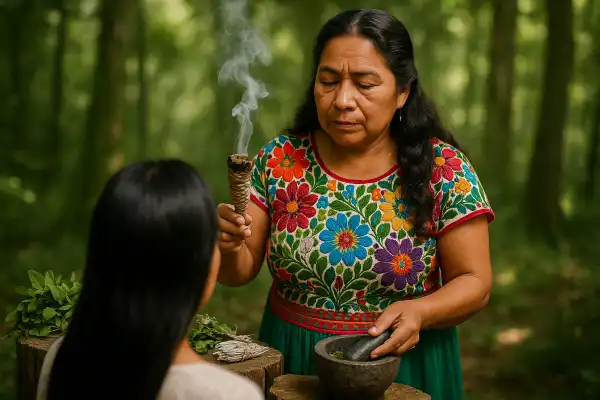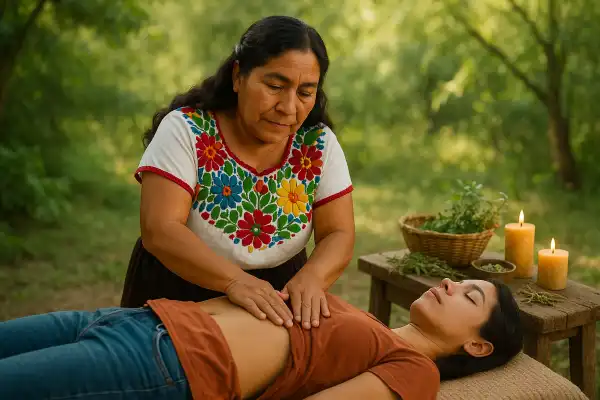Healing methods in curanderismo encompass a vast tapestry of sacred practices that have sustained indigenous Mexican communities for millennia. These ancestral techniques address the complete person—body, mind, and spirit—recognizing that true wellness emerges from harmony within ourselves and with the natural world.
María del Pilar Fernández draws upon her deep lineage of curanderas to illuminate these time-honored healing modalities. Through years of apprenticeship and practice, she has witnessed how these methods continue to offer profound restoration to those seeking authentic healing in our modern world.
Healing methods in curanderismo
Curanderismo represents a holistic healing system that blends indigenous Mexican wisdom with Catholic and other cultural influences, creating a comprehensive approach to wellness that has been practiced for over 5,000 years. The healing methods within this tradition work to restore balance between the physical, emotional, mental, and spiritual aspects of human existence.
Limpias: spiritual cleansings for energetic renewal
Limpias, or spiritual cleansings, form the cornerstone of curanderismo healing practices, designed to clear negative energies and restore harmony to the body and spirit. These ceremonies create sacred space for deep healing and transformation.

The most recognized limpia involves using a raw egg to absorb negative energy from the person’s energy field. During an egg cleansing, the curandera gently rolls an unbroken egg over the entire body while offering prayers, then cracks it into a glass of water to divine what energetic blockages were present. The patterns formed in the water reveal important information about the person’s spiritual and emotional state.
Other limpia methods incorporate aromatic healing herbs like ruda (rue), romero (rosemary), and albahaca (basil), along with copal smoke, candles, and sacred waters. Each element serves a specific purpose in clearing stagnant energy and inviting fresh life force to flow through the person’s being.
Sobada: traditional therapeutic massage
Sobada represents a specialized form of therapeutic massage developed in Mesoamerica, focusing particularly on internal organ alignment and abdominal healing. This profound bodywork addresses both physical ailments and emotional imbalances stored within the body.

Traditional sobadores work with pregnant women to position the baby correctly for birth, support the mother’s comfort during pregnancy, and aid in postpartum recovery. For others, sobada helps realign internal organs, improve circulation, and release muscular tensions that manifest from emotional stress.
The massage typically takes place on the floor using herbal oils and may include the use of a rebozo (traditional shawl) to support proper organ positioning after treatment. This ancient practice recognizes the intimate connection between physical structure and emotional well-being.
Ventosas: gentle fire cupping for circulation
Ventosas, the traditional Mexican form of cupping therapy, differs from other cupping practices through its gentler application and shorter duration on the skin. This method enhances blood circulation while providing a soothing therapeutic experience.
The glass cups are applied briefly to warm the body and activate blood vessels, then oil is used to create a massaging movement across the skin. Unlike other forms of cupping, ventosas can be applied to areas like the abdomen, arms, and legs, making it particularly useful for digestive issues and muscular tension.
This technique proves especially beneficial for those suffering from chronic pain, muscle stiffness, or circulation problems, offering relief without the intensity of other bodywork methods.
Manteadas: shawl alignments for structural healing
Manteadas involve the use of linen strips or traditional shawls to gently massage soft tissue and realign the body’s structure. This full-body treatment addresses imbalances in the musculoskeletal system while providing profound comfort and security.
The rhythmic movements of the cloth against the body help release trauma stored in the tissues and restore proper joint mobility. Manteadas prove particularly effective for muscle tension, limited range of motion, and even supporting the repositioning of breech babies during pregnancy.
This technique honors the healing power of touch while recognizing that true alignment encompasses both physical structure and emotional harmony.
Herbal medicine and plant remedies
Plant medicine forms an essential foundation of curanderismo, utilizing the healing properties of herbs like aloe vera for skin conditions and digestive support, while papaya aids in digestive health. Each plant carries specific energetic qualities that support different aspects of healing.
Traditional preparation methods include creating tinctures, herbal oils, teas, and poultices that work synergistically with the body’s natural healing processes. Modern research continues to validate many of these traditional uses, such as aloe vera’s anti-inflammatory and antibiotic properties.
The selection and preparation of herbs involves understanding both their physical properties and their spiritual significance within the healing process.
Treatment of traditional ailments
Curanderismo addresses specific cultural ailments like empacho (intestinal blockage), which is treated through abdominal massage with eggs to locate and release the blockage. These conditions represent disturbances in the body’s natural flow that require specialized intervention.
Other traditional ailments include susto (soul loss from fright), mal de ojo (evil eye), and mollera caída (fallen fontanel in infants). Each condition requires specific healing protocols that address both the physical symptoms and underlying spiritual causes.
The treatment approach always considers the whole person, recognizing that physical ailments often reflect deeper imbalances in one’s life circumstances or emotional state.
Integration of prayer and ritual
Prayer and connection with divine beings form the spiritual foundation of all curanderismo healing practices, with curanderos believing that true healing power comes from God or higher spiritual forces. Each healing session begins and ends with sacred invocations.
Rituals may incorporate the four directions, sacred symbols, candles, and specific timing based on lunar cycles or days of the week considered most powerful for healing work. These elements create a container of sacred energy within which healing can unfold.
The integration of Catholic saints and indigenous spiritual practices reflects the mestizo heritage of curanderismo, honoring both traditions while creating something uniquely powerful.
Disclaimer
Please note that Maria is not a physician, psychologist, or nurse. These culture-specific spiritual healing services are not meant to replace medical or psychological diagnosis and treatment. It is recommended that you see a licensed physician or licensed health care professional for any physical or psychological ailment you may have.
Last month, María received a visit from Lucia, a young mother whose infant son had been crying inconsolably for weeks despite multiple doctor visits showing nothing wrong. The child barely slept and seemed to startle at the slightest sound. María recognized the signs of susto—a condition where fright causes the soul to partially leave the body.
Working with gentle prayer and a traditional limpia using fresh herbs from her garden, María carefully cleansed the baby’s energy field while his mother held him close. She prepared a tea of manzanilla (chamomile) for the mother to drink, knowing that the child would receive the calming benefits through nursing. María also taught Lucia protective prayers to recite daily and placed a small red ribbon on the baby’s clothing to shield him from future spiritual disturbances.
Within three days, the infant began sleeping peacefully through the night. His crying decreased dramatically, and his bright, alert eyes returned. Lucia learned that during her pregnancy, she had witnessed a serious car accident that deeply frightened her—this trauma had affected her unborn child’s spiritual well-being. Through curanderismo’s understanding of the interconnection between mother and child, María was able to heal what conventional medicine could not address.
